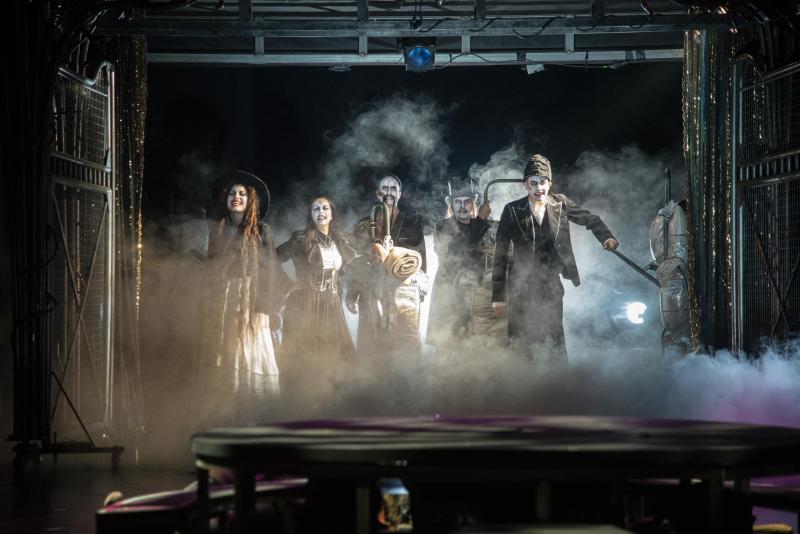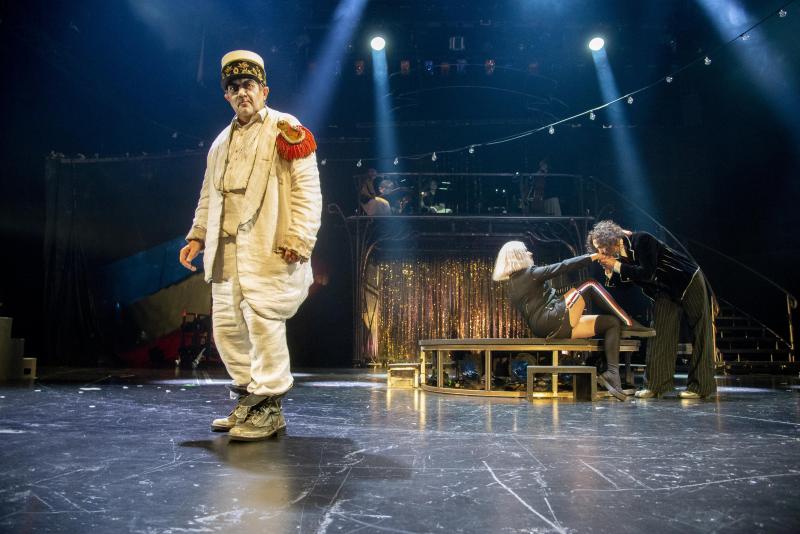Review: MUSTA SAARA (SARAH THE BLACK) at the Finnish National Theatre

A review and analysis of Musta Saara (Sarah the Black). Some spoilers included.
Moral. Value of a human being. Political and cultural correctness.
Europe. Circus.
A painted curtain blocks the view to the stage. The lights turn off in the audience and our attention is drawn to the gently lit up fire camp behind it. An inviting Romani music starts playing and thus we wait and gaze for a good long moment. The curtain raises up and the performance is afoot.
And so are the Romani people in this play and in all Europe outside the walls of the National Theatre.

Sara the Black (Musta Saara) at the Finnish National Theatre covers some tough and hard, irritatingly close-by topics: Europe's situation and its Romani people. The show is mainly focused on two French politicians Janne-Maria Teräväkynä ("Sharp-pen") and his daughter Marina Teräväkynä who strive to rule the government. Some playful off-character fourth-wall breaking chit-chat company to the audience is offered by three fiery women Sinikka Sokka, Ulla Tapaninen and Tiina "Tinze" Weckström. Each actress flexibly takes on characters from representing Freedom or a Road sign to Valkyries who lurk after land borders. We will also meet a dancing bear and a thin pig who both struggle choosing whether to stay in the old forest or to face new possibilities.
The play is about Romani people, but the actors, nonetheless, are all Finnish. Not a long time into the play after we hear the actors shouting from the stage, off-character: "Whose got the responsibility? There has to be a context!" One of the actresses state after being questioned of the correctness to play and tell a story of a character that belongs to a minority she isn't herself. Though is the responsibility on the writer? On the director? No, certainly it is got to be on the head-director of the National Theatre. Or is it on the audience, after all who choose to interpret and judge the show however they wish? The performance's own introspection lightens up the overall mood and murkiness of the show at hand throughout the play. Usually it's Ulla, one of the dynamic trio, who irritatedly implies that they have to move on to the next act. There's also straight dialogue with the audience after the interval as we are asked if we enjoyed our coffee. "There's no road any more, we're already in the next scene" is also a way we're being entertained through questioning our imagination in the set of a theatre show, and exquisitely so.

Black Sara never stopped surprising, for example with its witty use of various props, whether roller-shoes that made one character eerily hoover across the stage or papersnow that took its form as flying money later in the show. Or when a stage man gently taps a wooden, rolling structure that is meant to be a horse. The stage lighting with its color scheme was also professionally thought out as one was able to point out many complimentary colors that brought dynamics to the stage, whether as national flags or just as little fine details in the otherwise dark stage. Some objects also took opposite meanings, for example the bulblights which at the beginning of the show just a while ago lit up the faces of the poor Romani people, were then later a part of a glamorous sequin-show of the dynamic trio. Something that made me smile was also the conductor who was so with it and shouted hep hep hep to the up-beat Romani music, not almost staying on his seat.
The play is full of good chemistry between the characters. Something that caught my attention was Marina Teräväkynä's and Mircea's extraordinary synchronisation in the scene where they were represented for the first time. In the same scene the only not so working thing was how unconvincing Mircea's typing was, for example compared to the other typer in this play, the long and thin pig. Was there a difference on purpose? And whose got the responsibility of it? Is it on the actor, director or on the audience? Who knows. Only ten minutes into the play and something made me write in my notebook: "is Europe's situation a mere circus?" Janne-Marina Teräväkynä led the play on like a ringmaster alongside with the exiting drums and the white, clown-like faces of all the actors left in-awe from time to time. Many of the things were told aloud too: here's the imaginary Eiffel-tower. The scene changes now... Did it try to message that Europe would need a clear leader or leaders? The people, like we, audience need someone who'd tell us what's going on and where to go from here.

One of my favorite moments is a little hard to translate in English. Marina Teräväkynä spoke about "a noisy gong or a clanging cymbal", which is a Biblical reference, one of the few in this play, and that she lacked-- not love but a solution. In Finnish love is rakkaus and solution is ratkaisu so they have the same beginning "ra" and thus its well thought out lengthening took the audience by surprise and made us to realise that no, there's no room for love, but the tragedy goes on in this play. Something I took notice of was how in many dramatic scenes our leader-ringmaster Janne-Maria just sat in his chair, reading a newspaper. It made me think whether the actual lead of the world only sits on their arses in the same way, just reading the headlines of the catastrophes and agony, the headlines where they themselves may be mentioned too.
The play has some amazing choreography and music. The scene with the song "Tasa-arvo (Equality)" was finely rehearsed from big movements to the small turning of heads. It became one of my favorite scenes in the show. "Napakasti rapataan (Vigorously scrubbing)" -song gained a heart in my notebook. Also little, perhaps accidental beauty happened, when the barbed wire gently swung in the rhythm of the music. The performance also knit together perfectly its advertising and story that we faced inside the theatre: they were talking about the Joker playcard, which has his tongue out mischievously and what is its meaning. Nothing else came to my mind but Janne-Maria's face covered in white as the reddish tongue hangs out of the mouth, which we saw only in the advertisement before. The talented Romani-ensemble was at its best in the dramatic "Siellä on ihmisiä! (There are people)" -shout out. The group dynamics was great. Somewhere I'd have needed more in-sync and clearer choreography was the Joker song -scene's heads, so that the experience would have been enjoyable to the maximum.

Musta Saara is about some real and recent happenings, but also leaves a lot to be interpreted. A so called "Shakespearean transfer" where the playwright takes the happenings out of her own country, which she wants to criticize to Denmark, for example, or in this case to Frane. I do believe I was able to note one straight reference to a Finnish politician in the characters names, though.
Four actors ended up being my favorites: Ulla Tapaninen's intense presence and way of speaking did make an impact every time. Juha Muje's legendary voice as Janne-Maria Teräväkynä gave the play a great pace. Erkki Saarela as the dancing bear had an accurate and flowy physique and Janne Marja-Aho as Mircea ruled the art of being still on the stage. Marja-Aho found the magic from small expressions and a blank, staring face that ended up extremely interesting and magical to watch. One of the most dynamic scene was undoubtedly at the end, when the market started. "What's your offer?!" Was shouted out loud and then it came: the circus sound effect. I understood I'd taken the hint from the start. Europe's situation is nothing else but circus.
All in all Musta Saara is the spectacle of this Fall. With catchy songs, thought out set of lighting, costumes, great acting and an important storyline, this show shows what the National Theatre can do at its best. I could imagine it being performed anywhere in the world, in the right context, though. Touché!
... And the pig did the floss-dance.
Photos: Tuomo Manninen
Article: Rosanna Liuski

Reader Reviews

Videos
